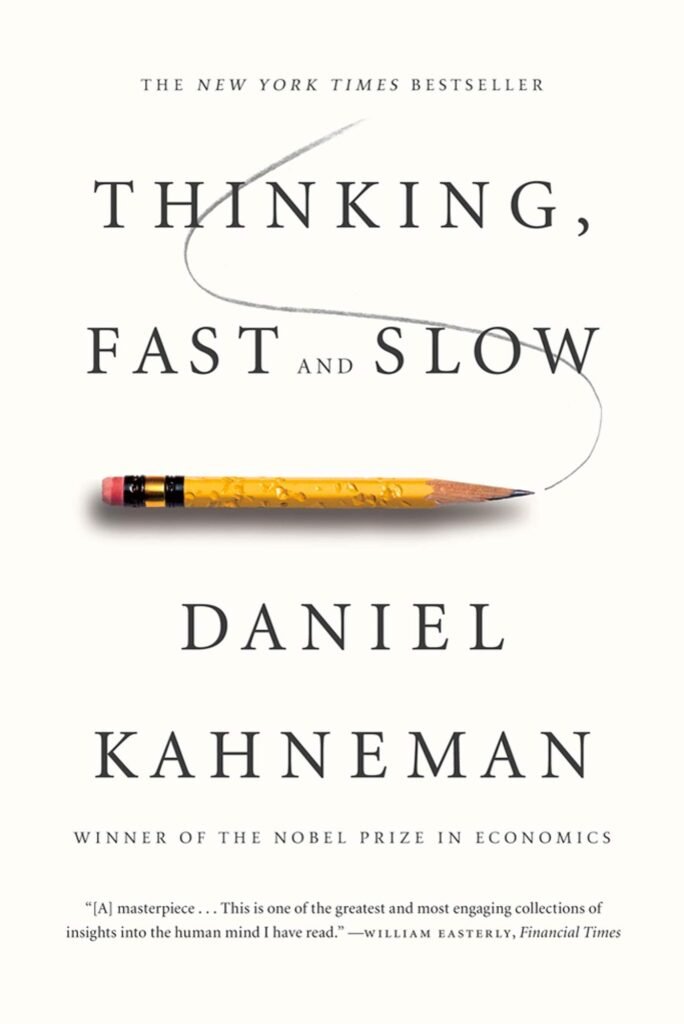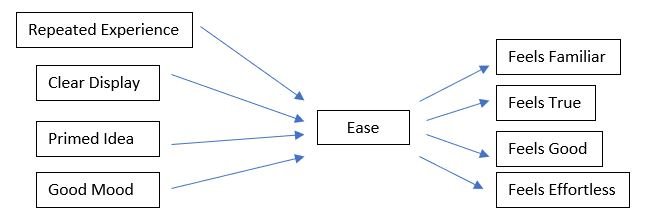"Thinking fast and Slow" by Daniel Kahneman: the "bible" of consumer behavior
In this post we’ll discover the insights of one of the most famous personality in the field of psychology and consumer behavior: Daniel Kahneman. Winner of the noble prize of economy for his work on heuristics and biases, his contributions helped to better understand how we make decisions in our daily life. Here I will present some of the most interesting discoveries he made with his colleague Amos Tversky.
System 1 et System 2
First of all, the core of his theory lies on the distinction between two systems in your brain. He called them system 1 and system 2.
System 1 is like an automatic mode in your brain. We do not have to consciously thought about our actions when we use it, with no or little effort . Some functions presented by the author include:
- Detect than one object is more distant than others
- Orient to the source of a distant sound
- Complete the phrase “Bread and…” or “just do…”
- Detect hostility in a voice
- Compute 2+2
- Drive a car in an empty road
- Read words on a large billboards
- Ride a bicycle once you mastered it
System 2 allocates attention to effortful mental activities such as complex choices, reflexion and concentration. System 2 performs a lot of function but they all share something in common: they require attention.
Kanheman gives us a non exhaustive list of examples of these functions:
- Focus attention on a clown in a circus
- Focus on a particular voice in a crowd
- Look for a women with brown hair
- Research memory to identify a surprising sound
- Maintain a faster walking speed than is natural for you
- Count the occurrence of the letter B in a text
- Tell someone your phone number
- Park on a narrow space
- Fill out a tax form
- Check the validity of a complex logical argument
- Compare two microwaves

An important point to remember is that system 1 and system 2 does not correspond to specific brain regions or can’t be identified physically. They are just concepts developed in order to better understand and visualize how we make decisions
As self-control and cognitive effort are forms of mental work, they can be impacted if your brain is already performing a task requiring mental efforts. For example, you are required to retain a 7 digit number, and retaining this number is your top priority.
If when you are processing this task, you are offered a choice between two desserts, you are more likely to choose the one with most sugar or the least healthy, indeed as your system 2 is already working on a task, your system 1, which has a sweet tooth, takes the lead for this choice.
It has also been proven that when you are on cognitive load, you will loser self-control and therefore make more selfish and superficial decisions and use sexist language.
-
- A bat and and ball cost 1.10$
- The bat costs one dollar more than the ball
- How much does the ball cost?
Following a quick reasoning and your intuition , a number comes to your mind: 10 cents. But when you think more about it, your system 2 investigates your answer and usual comes with the right answer. 1.05 dollar
- It takes 5 machines, 5 minutes to make 5 widgets, how long would it take 100 machines to make 100 widgets (100 minutes or 5 minutes)
- In a Lake, there is a patch of lily pads. Every day the patch doubles in size. If it takes 48 days for the patch to cover the entire lake, how long would it take for the patch to cover hale of the lake (24 days or 47 days)
Another effect of system 1 is the tendency to believe statement or ideas that “seems” true, even when it is not. This automatic processing makes it very difficult to disbelieve the idea or belief later on.
WYSIATI : What You See Is All There Is (Ce que vous voyez c’est tout ce qu’il y a)
This important concept developed by Kahneman and exposed throughout the whole book expose the process of system 1. We are eager to jump to conclusion and to take only the information in front of us to make a judgement.
For example, at the question “Will Carrie be a good leader? She is intelligent and strong…”, an answer comes quick to your mind: yes. You took the best decision based on the information presented, however the next adjectives could have been corrupt and cruel. Indeed, pour brain wants stores that are coherent.
Bias & Theories
Effet d’amorçage et effet de cadrage :
The priming effect shows that we will give answer or make decisions based on a “primed idea”. it is widely used in psychology experiment. By assigning a stimulus to someone, we hope to provoke another stimulus.
An illustration of the priming effect can be the following
- If you have seen recently the word EAT, you will be tempted to complete S__P by SOUP and not SOAP. This is the same as if you see WASH, SOAP is more likely to come out. Then the concept of EAT primes the concept of SOUP and the same with WASH ans SOAP
Concerning the framing effect, the authors works most intensively on this cognitive bias. It reveals that we decide options based on how it is presented, negatively or positively, as a loss or a gain. For example we’ll tend to feel more confident to have a surgical operation if it presented with a 95% succeed rate rather than 5% of failure.
A famous example of framing effect is the Asian disease problem:
“Imagine that the US is preparing for the outbreak of an unusual Asian disease, which is expected to kill 600 people. Two alternatives programs to combat the disease have been approved. Assume that the exact scientific estimates of the consequences of the programs are as follow
- f program A is adopter, 200 people will be saved
- if program B is accepted, there is a one third probability that 600 people will be saved and Two thirds probability that no people will be saved
- if program A’ is adopter, 400 people will die
- if program B’ is adopted, there is a one third probability that nobody will die and two thirds probability that 600 people will die
Look closely and compare the two versions: the consequences of program A and A’ are identical; so are the consequences of programs B and b’. In the second frame however, a large majority of people choose the gamble”
The Prospect Theory :
Another theory developed by Kanheman is the prospect theory. It assumes that losses are weighted more than gains. Also known as the loss aversion theory.
For example, most people won’t go for the following bet: 50% chance of winning 100 and 50% chance of Losing 100.
The author illustrates the example with the following graph:
There are 3 principles to this theory.

- The principle of diminishing sensitivity. If you turn on a weak light on a dark room it will have a large effect. If you increase the power of the light by the same increment in a brightly illuminated room, it will have a smaller effect. The same principle applies with money. An increase of gain from 900$ to 1000$ will have a smaller effect than from 100$ to $200
- The principle of loss aversion. “When directly compared or weighted against each other, losses loom large than gains”. This principle has an historical root: living being that weight threats more than opportunities have better chances of survival
We can sum up the prospect theory with this table: the fourfold pattern

- The top left cell: “people are averse to risk when they consider prospects with a substantial chance to achieve a large gain. They are willing to accept less than the expected value of a gamble to lock in a sure gain”
- The bottom left cell: “the possibility effect (…) explains why lotteries are popular. When the top prize is very large, tickets buyers appear indifferent to the fact that their chance of winning is minuscule. A lottery ticket is the ultimate example of the possibility effect.(…) what people acquire with a ticket is more than a chance to win; it is the right to dream pleasantly of winning”
- The bottom right cell: “is where insurance is bought. People are willing to pay much more for insurance than expected value (…) here again, people buy more than protection against an unlikely disaster; they eliminate a worry and purchase peace of mind”
He developed the concept of cognitive ease. It ranges between “easy” and “strained”. Ease means that no direct threat is identified, there is no need to redirection attention or mobilize effort: things are going well. Strained means that a problem is occurring, which require the mobilization of system 2. He explained that “cognitive strain is affected by both the current level of effort and the presence of unmet demand”.
We tend to be at cognitive ease when we are on a good mood or for example, when a sentence is written on a clear font, repeated, and primed, it will be processed with cognitive ease. According to him “when you feel strained, you are more likely to be vigilant and suspicions, invest more effort in what you are doing , feel less comfortable and make fewer errors but you also are less intuitive and creative as usual.

Peak-end Rule
We judge an experience mostly based on how we feel at its peak, the most intense part of the experience, and at its end rather than based on the sum or average of the experience. For example when we are treated for an operation without anesthesia, we’ll tend to judge that it was more painful if the pain was higher at the end even if the rest of the operation was not not painful at all, compared to Someone who experience a high and constant level of pain and a decrease at the end of the operation.
Thanks Daniel Kanheman and Amos Tversky for all these interesting insights.
